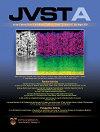在Cl2等离子体中蚀刻GaN时载流子晶片的影响
IF 2.1
3区 材料科学
Q3 MATERIALS SCIENCE, COATINGS & FILMS
引用次数: 6
摘要
在这项研究中,我们根据所使用的载流子晶片(Si, sio2, Si 3n4,光刻胶),在不同的偏置电压下,在Cl 2等离子体中蚀刻高达100 nm的GaN表面进行了彻底的表征。本文的目的是评估在蚀刻过程中存在具有其他化学性质的材料时氮化镓表面的蚀刻损伤和污染。采用XPS和AFM测量方法,详细研究了蚀刻条件对蚀刻GaN膜表面形貌和化学成分的影响。为此,提出了一种通用的方法,在只有Al - k - α x射线源的情况下,用XPS准确估计暴露于反应等离子体的GaN表面的化学计量学。结果表明,GaN蚀刻机制对等离子体中氯自由基密度非常敏感,而氯自由基密度受载流子晶片的影响较大。与sio2或si3n4相比,与Cl 2等离子体(如硅或光刻胶)化学反应更强的衬底将导致更大的氯原子负载,这反过来将导致更低的GaN蚀刻速率。此外,氮化镓表面污染将取决于蚀刻副产物喷出的载体晶圆。本文章由计算机程序翻译,如有差异,请以英文原文为准。
Influence of the carrier wafer during GaN etching in Cl2 plasma
In this study we have performed a thorough characterization of GaN surface after etching up to 100 nm in Cl 2 plasma under various bias voltage and according to the carrier wafer used (Si, SiO 2 , Si 3 N 4 , photoresist). The objective of this article is to evaluate the etch damage and contamination of the GaN surface when materials with other chemical nature are present during the etching. The effects of etching conditions on surface morphology and chemical compositions of etched GaN films are studied in detail using XPS and AFM measurements. To this aim, an universal methodology is proposed to estimate accurately by XPS the stoichiometry of GaN surface exposed to reactive plasmas when only a Al Kα X-ray source is available. The results indicate that the GaN etching mechanisms are very sensitive to the chlorine radical density present in the plasma, the latter being strongly influenced by the carrier wafer. Substrates that are more chemically reactive with Cl 2 plasma such as silicon or photoresist compared to SiO 2 or Si 3 N 4 will lead to a greater loading of atomic chlorine, which in turn will lead to lower GaN etch rates. Moreover, the GaN surface contamination will depend on the etch byproducts ejected by the carrier wafer.
求助全文
通过发布文献求助,成功后即可免费获取论文全文。
去求助
来源期刊

Journal of Vacuum Science & Technology A
工程技术-材料科学:膜
CiteScore
5.10
自引率
10.30%
发文量
247
审稿时长
2.1 months
期刊介绍:
Journal of Vacuum Science & Technology A publishes reports of original research, letters, and review articles that focus on fundamental scientific understanding of interfaces, surfaces, plasmas and thin films and on using this understanding to advance the state-of-the-art in various technological applications.
 求助内容:
求助内容: 应助结果提醒方式:
应助结果提醒方式:


